Regional Report: A Comprehensive Analysis of Ontario, Canada
VerifiedAdded on 2022/09/07
|12
|2198
|19
Report
AI Summary
This report provides a detailed analysis of the Ontario region in Canada, examining its economic activities, natural resources, population density, and social fault lines. The report highlights Ontario's dominant manufacturing, mining, and service sectors, as well as its rich natural resources including lakes, forests, and diverse wildlife. It explores population growth, immigration, and the core-periphery dynamics as described by Friedman's model, focusing on the concentration of population and industries in urban centers like Toronto. The report also delves into the economic outlook, identifying social fault lines related to income inequality and the impact of changes in the labor market. The conclusion emphasizes the challenges of population influx in urban centers and suggests strategies like industrial development in peripheral regions and infrastructure improvements to promote balanced growth and reduce unemployment. The report uses statistical data and references to provide a comprehensive overview of Ontario's regional characteristics.
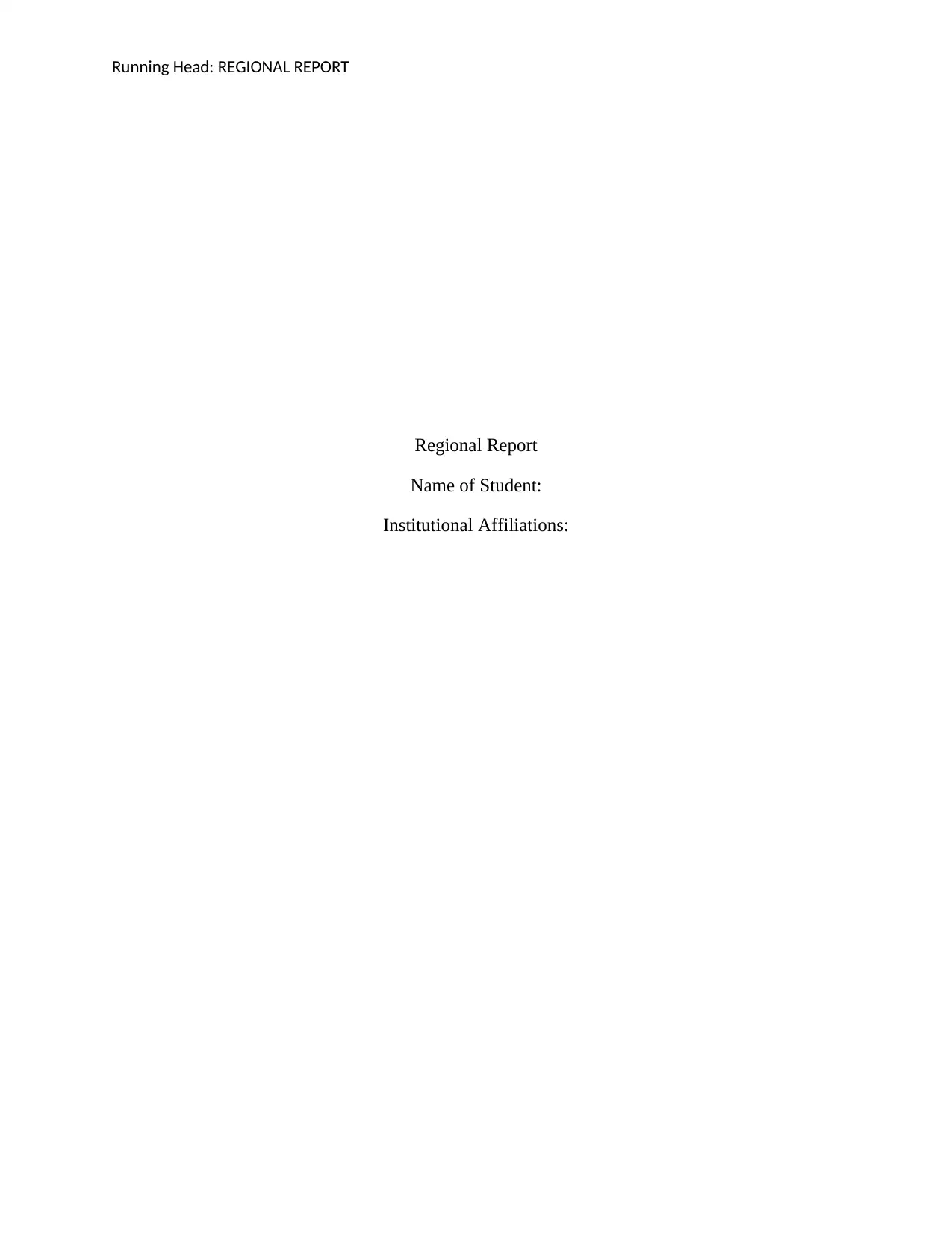
Running Head: REGIONAL REPORT
Regional Report
Name of Student:
Institutional Affiliations:
Regional Report
Name of Student:
Institutional Affiliations:
Paraphrase This Document
Need a fresh take? Get an instant paraphrase of this document with our AI Paraphraser
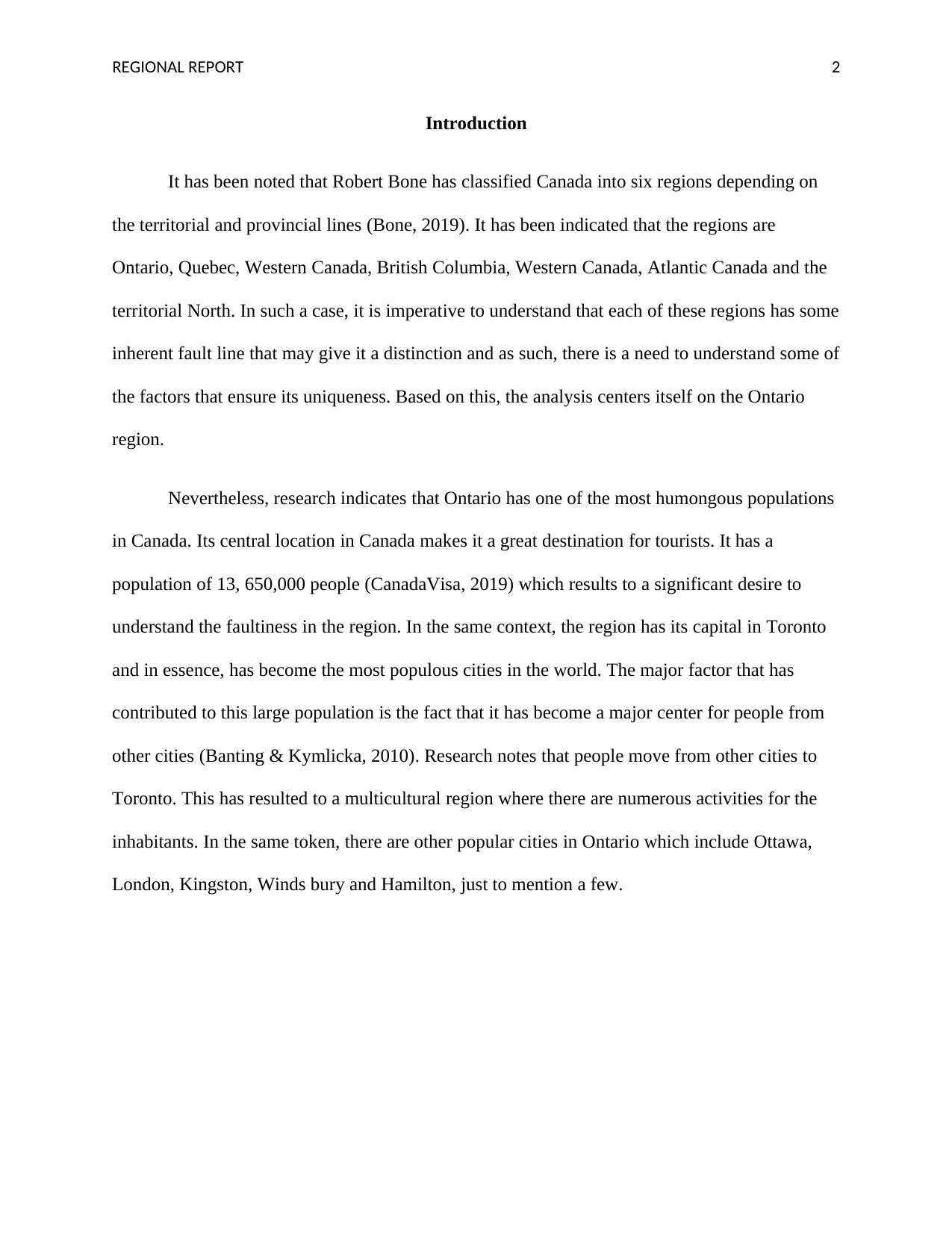
REGIONAL REPORT 2
Introduction
It has been noted that Robert Bone has classified Canada into six regions depending on
the territorial and provincial lines (Bone, 2019). It has been indicated that the regions are
Ontario, Quebec, Western Canada, British Columbia, Western Canada, Atlantic Canada and the
territorial North. In such a case, it is imperative to understand that each of these regions has some
inherent fault line that may give it a distinction and as such, there is a need to understand some of
the factors that ensure its uniqueness. Based on this, the analysis centers itself on the Ontario
region.
Nevertheless, research indicates that Ontario has one of the most humongous populations
in Canada. Its central location in Canada makes it a great destination for tourists. It has a
population of 13, 650,000 people (CanadaVisa, 2019) which results to a significant desire to
understand the faultiness in the region. In the same context, the region has its capital in Toronto
and in essence, has become the most populous cities in the world. The major factor that has
contributed to this large population is the fact that it has become a major center for people from
other cities (Banting & Kymlicka, 2010). Research notes that people move from other cities to
Toronto. This has resulted to a multicultural region where there are numerous activities for the
inhabitants. In the same token, there are other popular cities in Ontario which include Ottawa,
London, Kingston, Winds bury and Hamilton, just to mention a few.
Introduction
It has been noted that Robert Bone has classified Canada into six regions depending on
the territorial and provincial lines (Bone, 2019). It has been indicated that the regions are
Ontario, Quebec, Western Canada, British Columbia, Western Canada, Atlantic Canada and the
territorial North. In such a case, it is imperative to understand that each of these regions has some
inherent fault line that may give it a distinction and as such, there is a need to understand some of
the factors that ensure its uniqueness. Based on this, the analysis centers itself on the Ontario
region.
Nevertheless, research indicates that Ontario has one of the most humongous populations
in Canada. Its central location in Canada makes it a great destination for tourists. It has a
population of 13, 650,000 people (CanadaVisa, 2019) which results to a significant desire to
understand the faultiness in the region. In the same context, the region has its capital in Toronto
and in essence, has become the most populous cities in the world. The major factor that has
contributed to this large population is the fact that it has become a major center for people from
other cities (Banting & Kymlicka, 2010). Research notes that people move from other cities to
Toronto. This has resulted to a multicultural region where there are numerous activities for the
inhabitants. In the same token, there are other popular cities in Ontario which include Ottawa,
London, Kingston, Winds bury and Hamilton, just to mention a few.
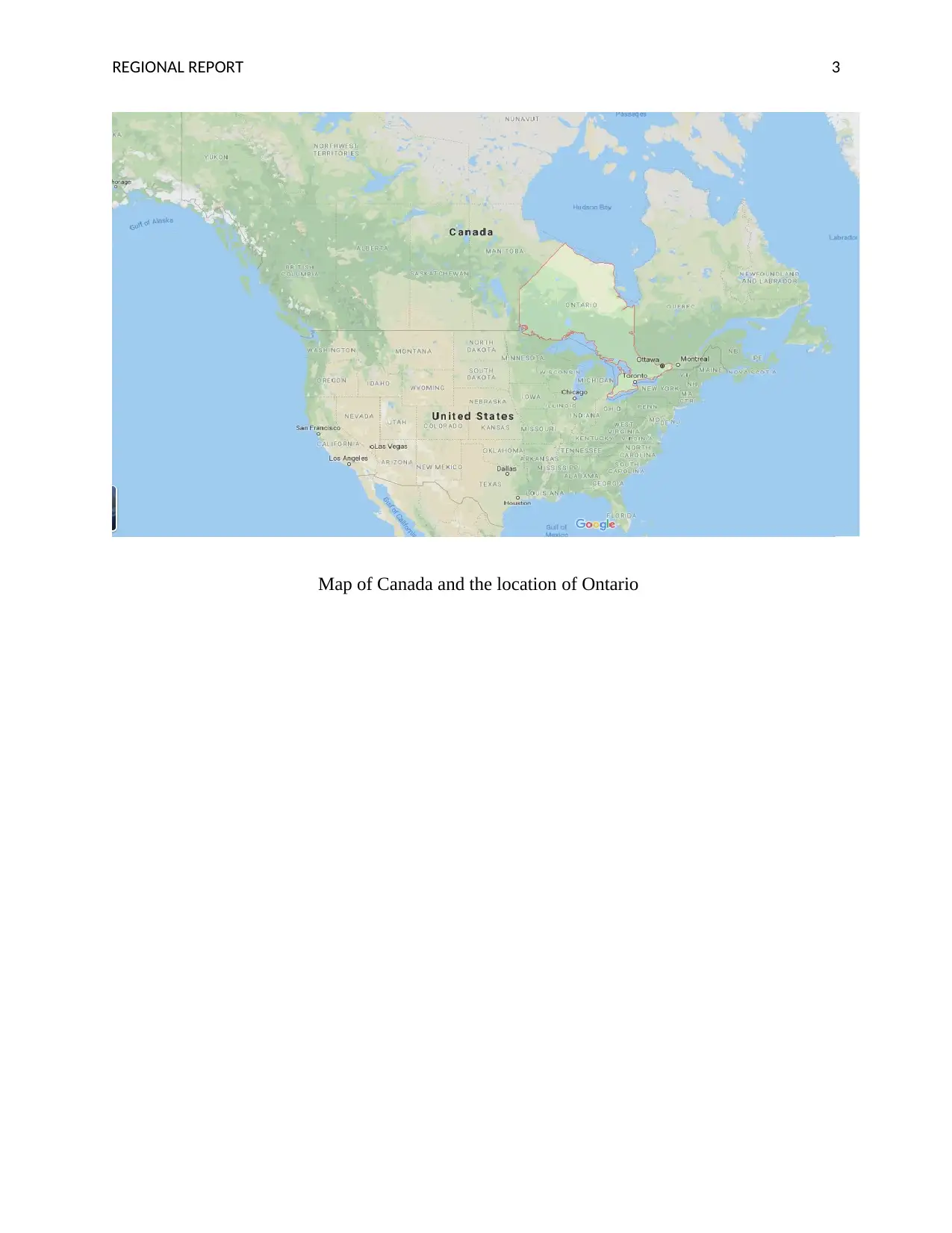
REGIONAL REPORT 3
Map of Canada and the location of Ontario
Map of Canada and the location of Ontario
⊘ This is a preview!⊘
Do you want full access?
Subscribe today to unlock all pages.

Trusted by 1+ million students worldwide
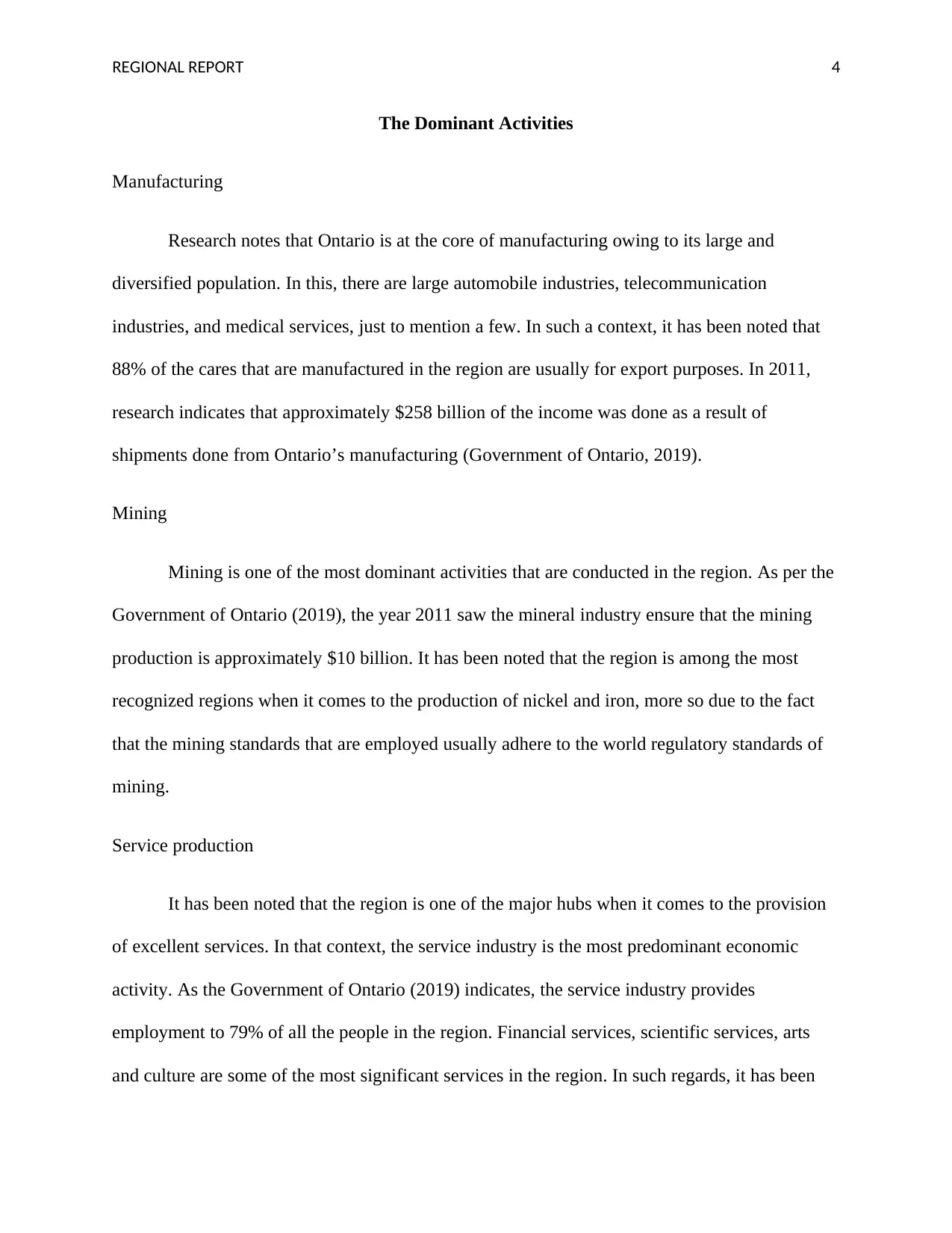
REGIONAL REPORT 4
The Dominant Activities
Manufacturing
Research notes that Ontario is at the core of manufacturing owing to its large and
diversified population. In this, there are large automobile industries, telecommunication
industries, and medical services, just to mention a few. In such a context, it has been noted that
88% of the cares that are manufactured in the region are usually for export purposes. In 2011,
research indicates that approximately $258 billion of the income was done as a result of
shipments done from Ontario’s manufacturing (Government of Ontario, 2019).
Mining
Mining is one of the most dominant activities that are conducted in the region. As per the
Government of Ontario (2019), the year 2011 saw the mineral industry ensure that the mining
production is approximately $10 billion. It has been noted that the region is among the most
recognized regions when it comes to the production of nickel and iron, more so due to the fact
that the mining standards that are employed usually adhere to the world regulatory standards of
mining.
Service production
It has been noted that the region is one of the major hubs when it comes to the provision
of excellent services. In that context, the service industry is the most predominant economic
activity. As the Government of Ontario (2019) indicates, the service industry provides
employment to 79% of all the people in the region. Financial services, scientific services, arts
and culture are some of the most significant services in the region. In such regards, it has been
The Dominant Activities
Manufacturing
Research notes that Ontario is at the core of manufacturing owing to its large and
diversified population. In this, there are large automobile industries, telecommunication
industries, and medical services, just to mention a few. In such a context, it has been noted that
88% of the cares that are manufactured in the region are usually for export purposes. In 2011,
research indicates that approximately $258 billion of the income was done as a result of
shipments done from Ontario’s manufacturing (Government of Ontario, 2019).
Mining
Mining is one of the most dominant activities that are conducted in the region. As per the
Government of Ontario (2019), the year 2011 saw the mineral industry ensure that the mining
production is approximately $10 billion. It has been noted that the region is among the most
recognized regions when it comes to the production of nickel and iron, more so due to the fact
that the mining standards that are employed usually adhere to the world regulatory standards of
mining.
Service production
It has been noted that the region is one of the major hubs when it comes to the provision
of excellent services. In that context, the service industry is the most predominant economic
activity. As the Government of Ontario (2019) indicates, the service industry provides
employment to 79% of all the people in the region. Financial services, scientific services, arts
and culture are some of the most significant services in the region. In such regards, it has been
Paraphrase This Document
Need a fresh take? Get an instant paraphrase of this document with our AI Paraphraser
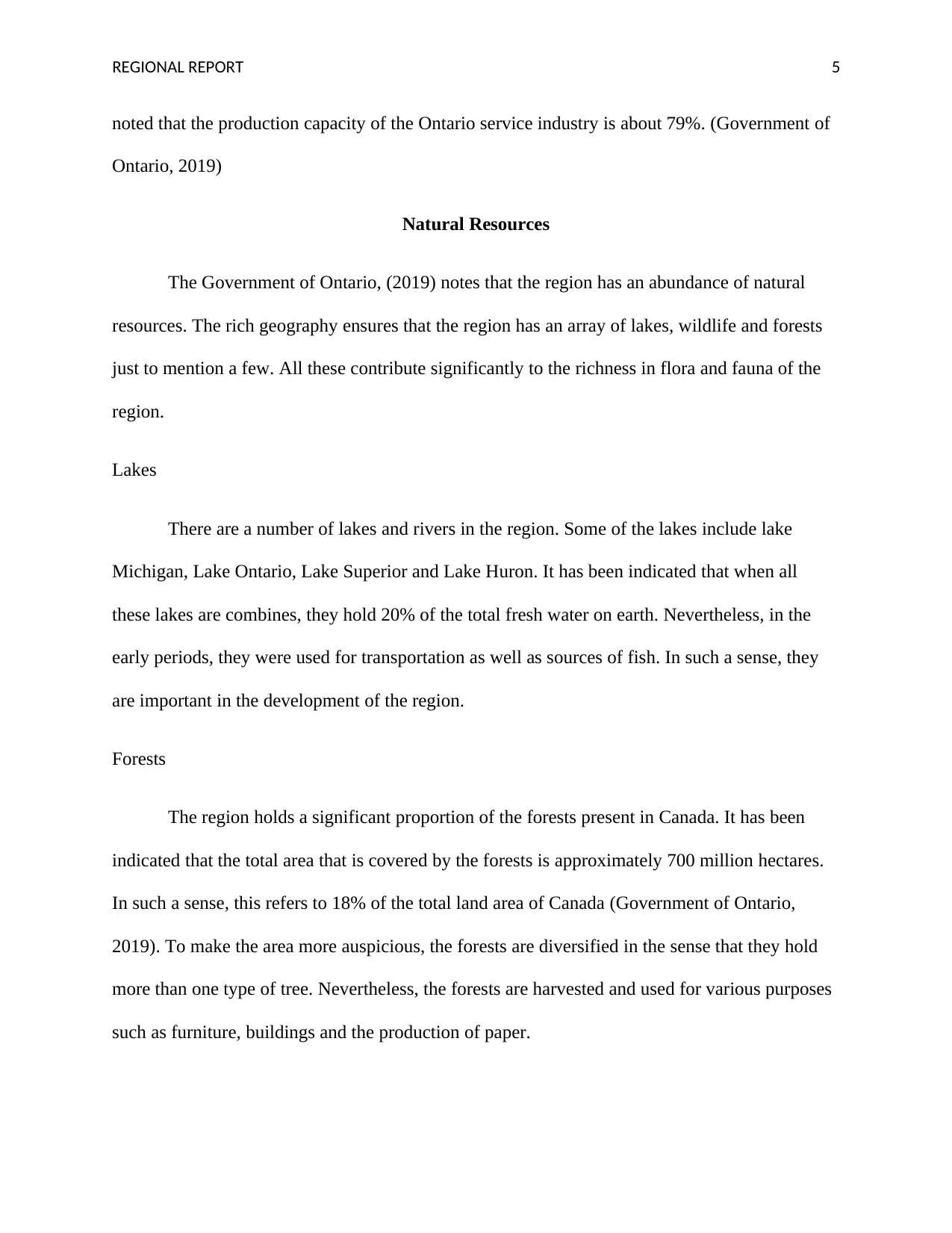
REGIONAL REPORT 5
noted that the production capacity of the Ontario service industry is about 79%. (Government of
Ontario, 2019)
Natural Resources
The Government of Ontario, (2019) notes that the region has an abundance of natural
resources. The rich geography ensures that the region has an array of lakes, wildlife and forests
just to mention a few. All these contribute significantly to the richness in flora and fauna of the
region.
Lakes
There are a number of lakes and rivers in the region. Some of the lakes include lake
Michigan, Lake Ontario, Lake Superior and Lake Huron. It has been indicated that when all
these lakes are combines, they hold 20% of the total fresh water on earth. Nevertheless, in the
early periods, they were used for transportation as well as sources of fish. In such a sense, they
are important in the development of the region.
Forests
The region holds a significant proportion of the forests present in Canada. It has been
indicated that the total area that is covered by the forests is approximately 700 million hectares.
In such a sense, this refers to 18% of the total land area of Canada (Government of Ontario,
2019). To make the area more auspicious, the forests are diversified in the sense that they hold
more than one type of tree. Nevertheless, the forests are harvested and used for various purposes
such as furniture, buildings and the production of paper.
noted that the production capacity of the Ontario service industry is about 79%. (Government of
Ontario, 2019)
Natural Resources
The Government of Ontario, (2019) notes that the region has an abundance of natural
resources. The rich geography ensures that the region has an array of lakes, wildlife and forests
just to mention a few. All these contribute significantly to the richness in flora and fauna of the
region.
Lakes
There are a number of lakes and rivers in the region. Some of the lakes include lake
Michigan, Lake Ontario, Lake Superior and Lake Huron. It has been indicated that when all
these lakes are combines, they hold 20% of the total fresh water on earth. Nevertheless, in the
early periods, they were used for transportation as well as sources of fish. In such a sense, they
are important in the development of the region.
Forests
The region holds a significant proportion of the forests present in Canada. It has been
indicated that the total area that is covered by the forests is approximately 700 million hectares.
In such a sense, this refers to 18% of the total land area of Canada (Government of Ontario,
2019). To make the area more auspicious, the forests are diversified in the sense that they hold
more than one type of tree. Nevertheless, the forests are harvested and used for various purposes
such as furniture, buildings and the production of paper.
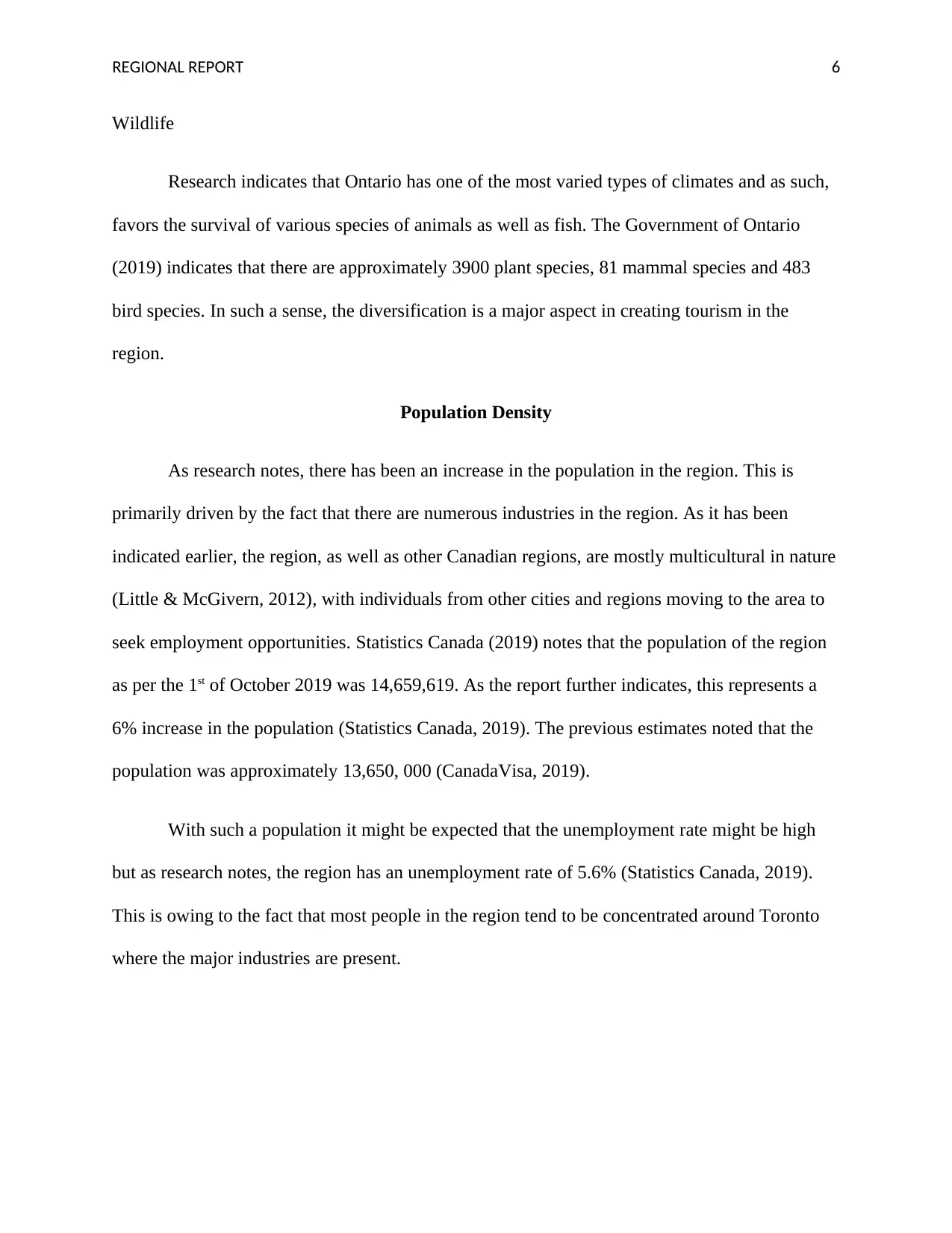
REGIONAL REPORT 6
Wildlife
Research indicates that Ontario has one of the most varied types of climates and as such,
favors the survival of various species of animals as well as fish. The Government of Ontario
(2019) indicates that there are approximately 3900 plant species, 81 mammal species and 483
bird species. In such a sense, the diversification is a major aspect in creating tourism in the
region.
Population Density
As research notes, there has been an increase in the population in the region. This is
primarily driven by the fact that there are numerous industries in the region. As it has been
indicated earlier, the region, as well as other Canadian regions, are mostly multicultural in nature
(Little & McGivern, 2012), with individuals from other cities and regions moving to the area to
seek employment opportunities. Statistics Canada (2019) notes that the population of the region
as per the 1st of October 2019 was 14,659,619. As the report further indicates, this represents a
6% increase in the population (Statistics Canada, 2019). The previous estimates noted that the
population was approximately 13,650, 000 (CanadaVisa, 2019).
With such a population it might be expected that the unemployment rate might be high
but as research notes, the region has an unemployment rate of 5.6% (Statistics Canada, 2019).
This is owing to the fact that most people in the region tend to be concentrated around Toronto
where the major industries are present.
Wildlife
Research indicates that Ontario has one of the most varied types of climates and as such,
favors the survival of various species of animals as well as fish. The Government of Ontario
(2019) indicates that there are approximately 3900 plant species, 81 mammal species and 483
bird species. In such a sense, the diversification is a major aspect in creating tourism in the
region.
Population Density
As research notes, there has been an increase in the population in the region. This is
primarily driven by the fact that there are numerous industries in the region. As it has been
indicated earlier, the region, as well as other Canadian regions, are mostly multicultural in nature
(Little & McGivern, 2012), with individuals from other cities and regions moving to the area to
seek employment opportunities. Statistics Canada (2019) notes that the population of the region
as per the 1st of October 2019 was 14,659,619. As the report further indicates, this represents a
6% increase in the population (Statistics Canada, 2019). The previous estimates noted that the
population was approximately 13,650, 000 (CanadaVisa, 2019).
With such a population it might be expected that the unemployment rate might be high
but as research notes, the region has an unemployment rate of 5.6% (Statistics Canada, 2019).
This is owing to the fact that most people in the region tend to be concentrated around Toronto
where the major industries are present.
⊘ This is a preview!⊘
Do you want full access?
Subscribe today to unlock all pages.

Trusted by 1+ million students worldwide
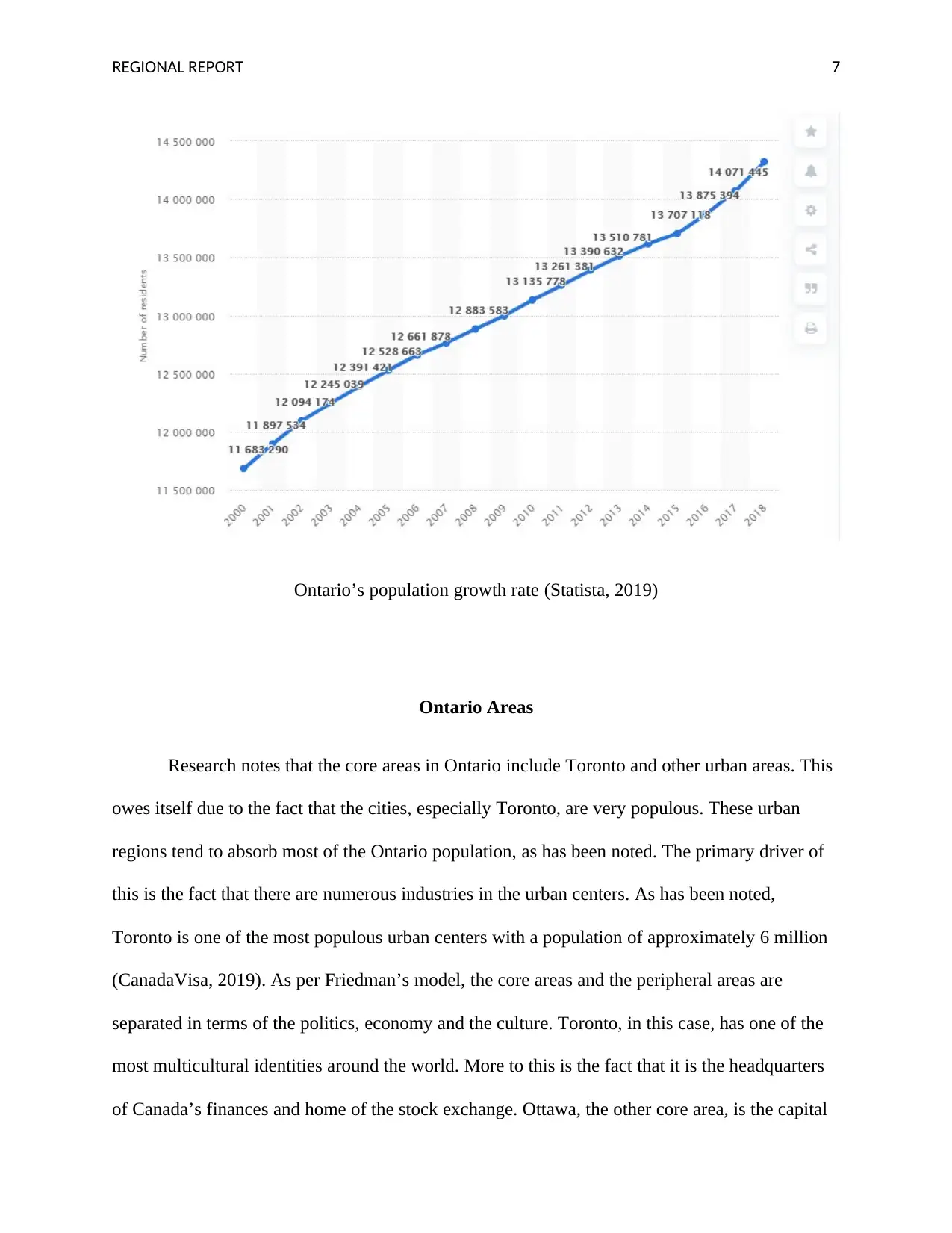
REGIONAL REPORT 7
Ontario’s population growth rate (Statista, 2019)
Ontario Areas
Research notes that the core areas in Ontario include Toronto and other urban areas. This
owes itself due to the fact that the cities, especially Toronto, are very populous. These urban
regions tend to absorb most of the Ontario population, as has been noted. The primary driver of
this is the fact that there are numerous industries in the urban centers. As has been noted,
Toronto is one of the most populous urban centers with a population of approximately 6 million
(CanadaVisa, 2019). As per Friedman’s model, the core areas and the peripheral areas are
separated in terms of the politics, economy and the culture. Toronto, in this case, has one of the
most multicultural identities around the world. More to this is the fact that it is the headquarters
of Canada’s finances and home of the stock exchange. Ottawa, the other core area, is the capital
Ontario’s population growth rate (Statista, 2019)
Ontario Areas
Research notes that the core areas in Ontario include Toronto and other urban areas. This
owes itself due to the fact that the cities, especially Toronto, are very populous. These urban
regions tend to absorb most of the Ontario population, as has been noted. The primary driver of
this is the fact that there are numerous industries in the urban centers. As has been noted,
Toronto is one of the most populous urban centers with a population of approximately 6 million
(CanadaVisa, 2019). As per Friedman’s model, the core areas and the peripheral areas are
separated in terms of the politics, economy and the culture. Toronto, in this case, has one of the
most multicultural identities around the world. More to this is the fact that it is the headquarters
of Canada’s finances and home of the stock exchange. Ottawa, the other core area, is the capital
Paraphrase This Document
Need a fresh take? Get an instant paraphrase of this document with our AI Paraphraser
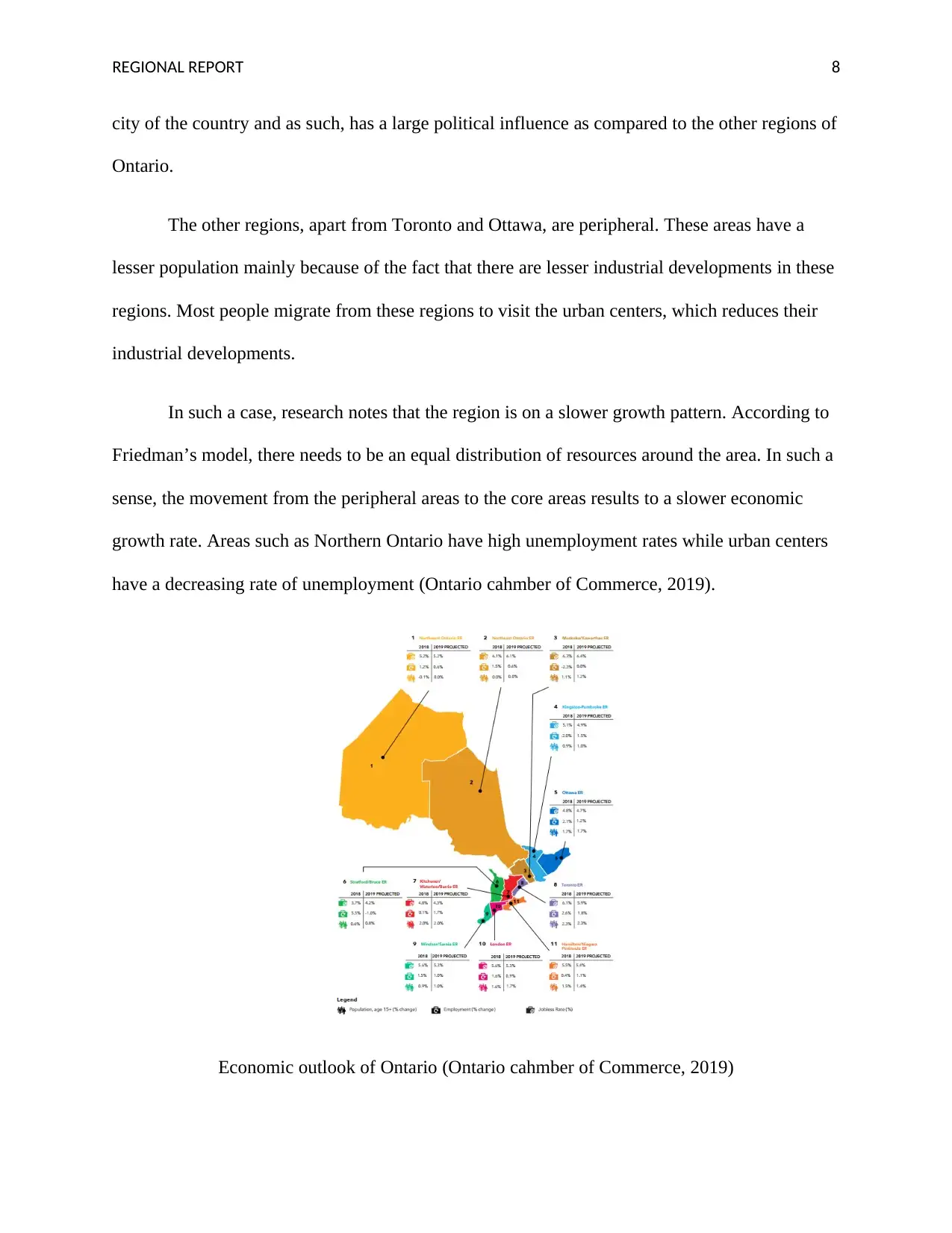
REGIONAL REPORT 8
city of the country and as such, has a large political influence as compared to the other regions of
Ontario.
The other regions, apart from Toronto and Ottawa, are peripheral. These areas have a
lesser population mainly because of the fact that there are lesser industrial developments in these
regions. Most people migrate from these regions to visit the urban centers, which reduces their
industrial developments.
In such a case, research notes that the region is on a slower growth pattern. According to
Friedman’s model, there needs to be an equal distribution of resources around the area. In such a
sense, the movement from the peripheral areas to the core areas results to a slower economic
growth rate. Areas such as Northern Ontario have high unemployment rates while urban centers
have a decreasing rate of unemployment (Ontario cahmber of Commerce, 2019).
Economic outlook of Ontario (Ontario cahmber of Commerce, 2019)
city of the country and as such, has a large political influence as compared to the other regions of
Ontario.
The other regions, apart from Toronto and Ottawa, are peripheral. These areas have a
lesser population mainly because of the fact that there are lesser industrial developments in these
regions. Most people migrate from these regions to visit the urban centers, which reduces their
industrial developments.
In such a case, research notes that the region is on a slower growth pattern. According to
Friedman’s model, there needs to be an equal distribution of resources around the area. In such a
sense, the movement from the peripheral areas to the core areas results to a slower economic
growth rate. Areas such as Northern Ontario have high unemployment rates while urban centers
have a decreasing rate of unemployment (Ontario cahmber of Commerce, 2019).
Economic outlook of Ontario (Ontario cahmber of Commerce, 2019)
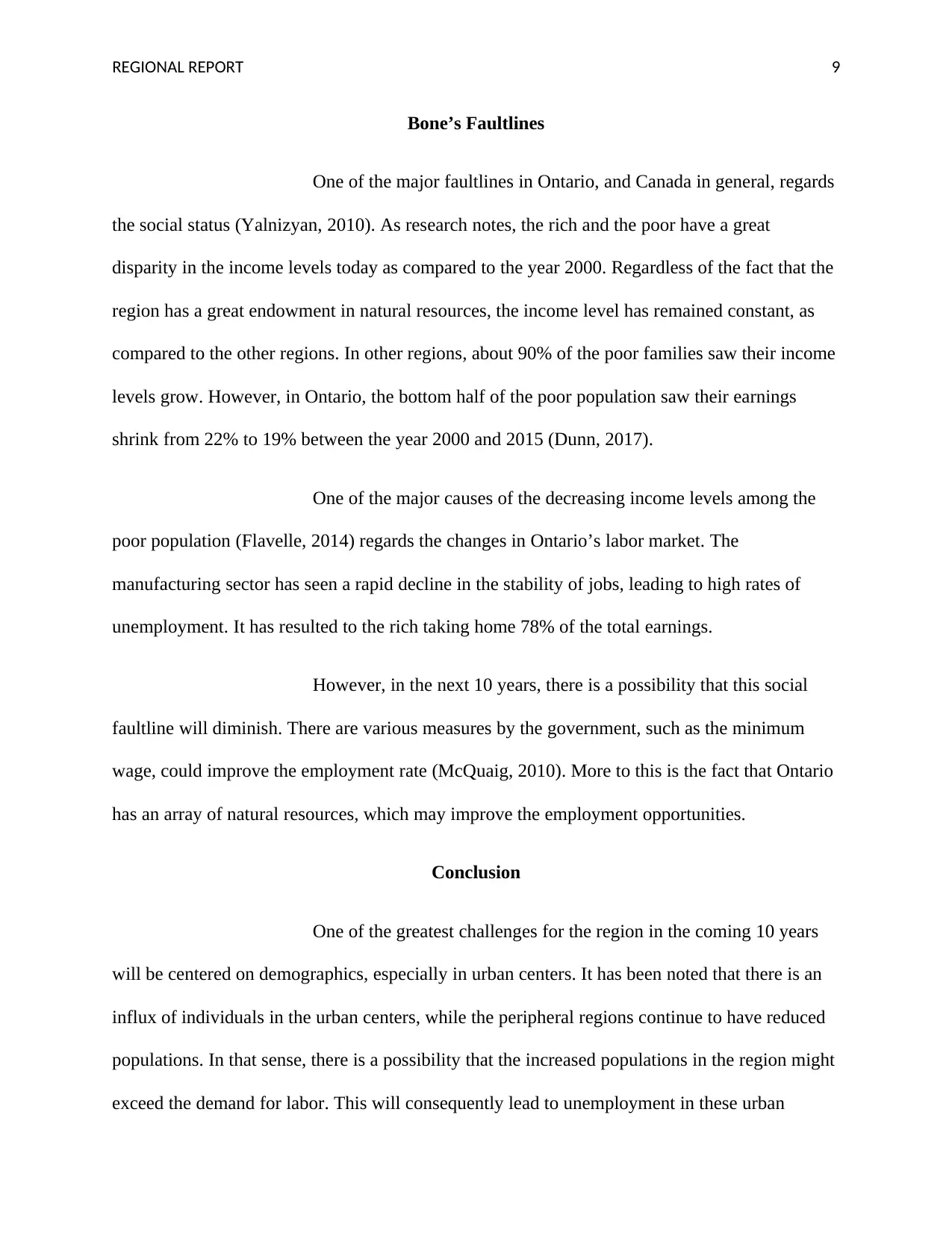
REGIONAL REPORT 9
Bone’s Faultlines
One of the major faultlines in Ontario, and Canada in general, regards
the social status (Yalnizyan, 2010). As research notes, the rich and the poor have a great
disparity in the income levels today as compared to the year 2000. Regardless of the fact that the
region has a great endowment in natural resources, the income level has remained constant, as
compared to the other regions. In other regions, about 90% of the poor families saw their income
levels grow. However, in Ontario, the bottom half of the poor population saw their earnings
shrink from 22% to 19% between the year 2000 and 2015 (Dunn, 2017).
One of the major causes of the decreasing income levels among the
poor population (Flavelle, 2014) regards the changes in Ontario’s labor market. The
manufacturing sector has seen a rapid decline in the stability of jobs, leading to high rates of
unemployment. It has resulted to the rich taking home 78% of the total earnings.
However, in the next 10 years, there is a possibility that this social
faultline will diminish. There are various measures by the government, such as the minimum
wage, could improve the employment rate (McQuaig, 2010). More to this is the fact that Ontario
has an array of natural resources, which may improve the employment opportunities.
Conclusion
One of the greatest challenges for the region in the coming 10 years
will be centered on demographics, especially in urban centers. It has been noted that there is an
influx of individuals in the urban centers, while the peripheral regions continue to have reduced
populations. In that sense, there is a possibility that the increased populations in the region might
exceed the demand for labor. This will consequently lead to unemployment in these urban
Bone’s Faultlines
One of the major faultlines in Ontario, and Canada in general, regards
the social status (Yalnizyan, 2010). As research notes, the rich and the poor have a great
disparity in the income levels today as compared to the year 2000. Regardless of the fact that the
region has a great endowment in natural resources, the income level has remained constant, as
compared to the other regions. In other regions, about 90% of the poor families saw their income
levels grow. However, in Ontario, the bottom half of the poor population saw their earnings
shrink from 22% to 19% between the year 2000 and 2015 (Dunn, 2017).
One of the major causes of the decreasing income levels among the
poor population (Flavelle, 2014) regards the changes in Ontario’s labor market. The
manufacturing sector has seen a rapid decline in the stability of jobs, leading to high rates of
unemployment. It has resulted to the rich taking home 78% of the total earnings.
However, in the next 10 years, there is a possibility that this social
faultline will diminish. There are various measures by the government, such as the minimum
wage, could improve the employment rate (McQuaig, 2010). More to this is the fact that Ontario
has an array of natural resources, which may improve the employment opportunities.
Conclusion
One of the greatest challenges for the region in the coming 10 years
will be centered on demographics, especially in urban centers. It has been noted that there is an
influx of individuals in the urban centers, while the peripheral regions continue to have reduced
populations. In that sense, there is a possibility that the increased populations in the region might
exceed the demand for labor. This will consequently lead to unemployment in these urban
⊘ This is a preview!⊘
Do you want full access?
Subscribe today to unlock all pages.

Trusted by 1+ million students worldwide
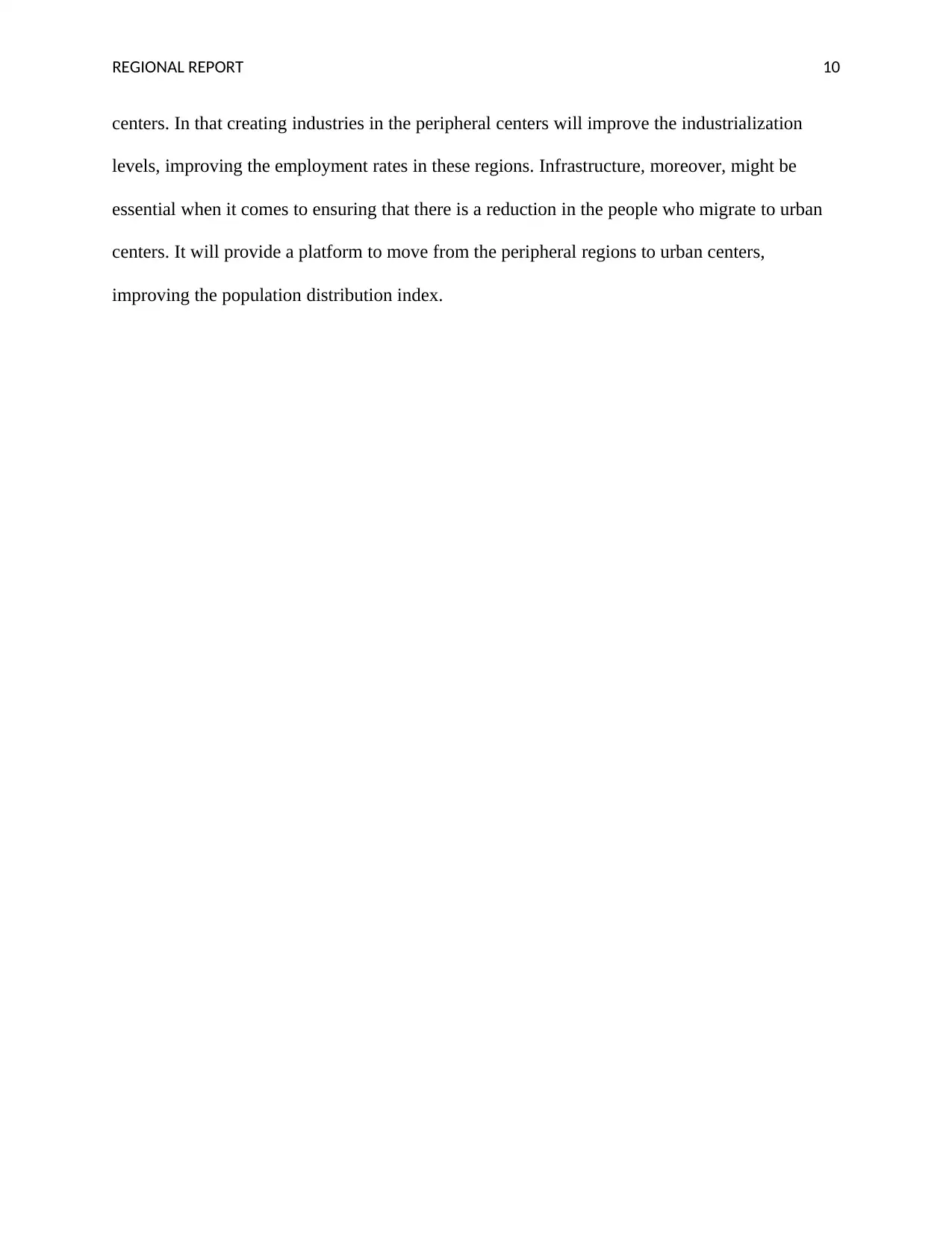
REGIONAL REPORT 10
centers. In that creating industries in the peripheral centers will improve the industrialization
levels, improving the employment rates in these regions. Infrastructure, moreover, might be
essential when it comes to ensuring that there is a reduction in the people who migrate to urban
centers. It will provide a platform to move from the peripheral regions to urban centers,
improving the population distribution index.
centers. In that creating industries in the peripheral centers will improve the industrialization
levels, improving the employment rates in these regions. Infrastructure, moreover, might be
essential when it comes to ensuring that there is a reduction in the people who migrate to urban
centers. It will provide a platform to move from the peripheral regions to urban centers,
improving the population distribution index.
Paraphrase This Document
Need a fresh take? Get an instant paraphrase of this document with our AI Paraphraser
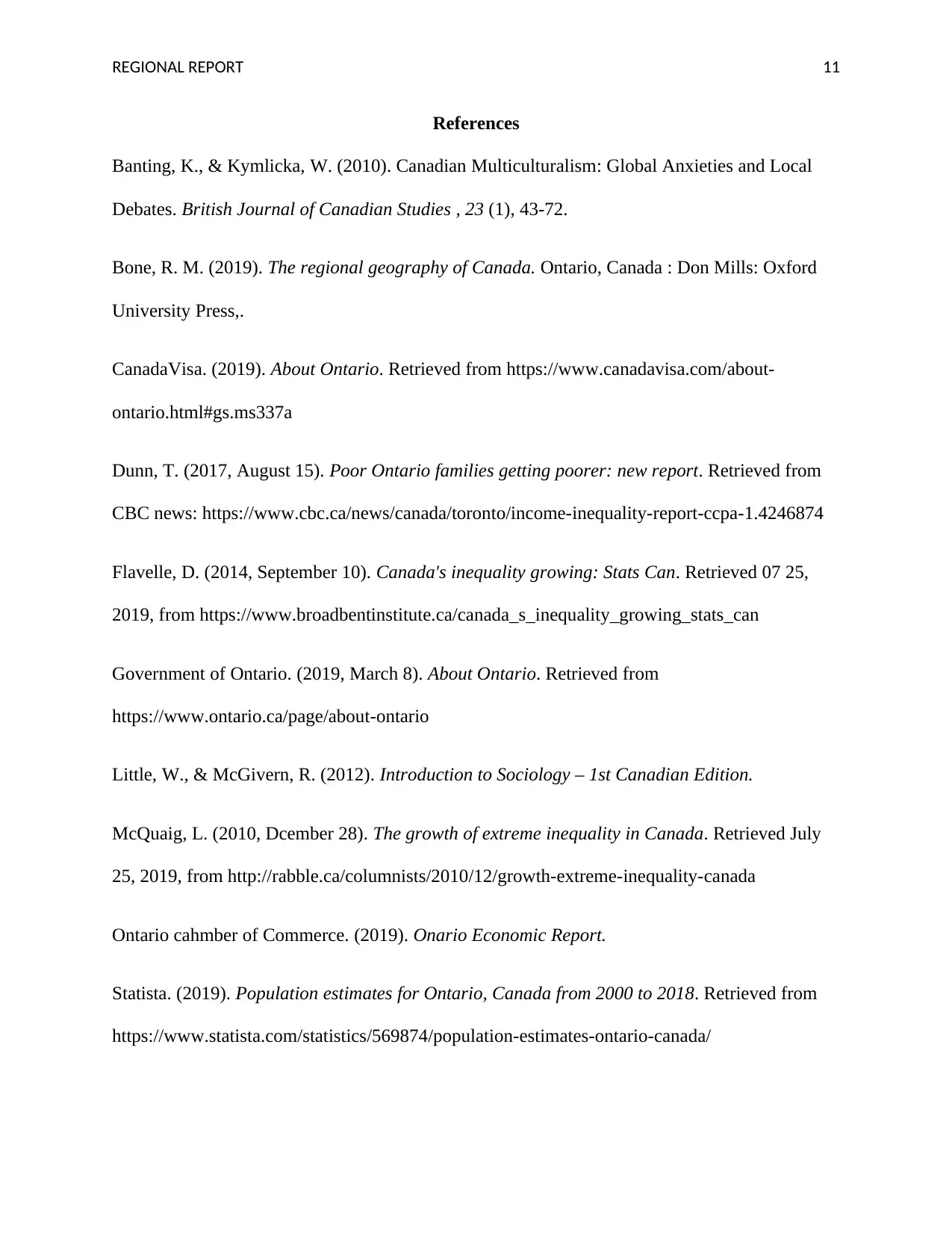
REGIONAL REPORT 11
References
Banting, K., & Kymlicka, W. (2010). Canadian Multiculturalism: Global Anxieties and Local
Debates. British Journal of Canadian Studies , 23 (1), 43-72.
Bone, R. M. (2019). The regional geography of Canada. Ontario, Canada : Don Mills: Oxford
University Press,.
CanadaVisa. (2019). About Ontario. Retrieved from https://www.canadavisa.com/about-
ontario.html#gs.ms337a
Dunn, T. (2017, August 15). Poor Ontario families getting poorer: new report. Retrieved from
CBC news: https://www.cbc.ca/news/canada/toronto/income-inequality-report-ccpa-1.4246874
Flavelle, D. (2014, September 10). Canada's inequality growing: Stats Can. Retrieved 07 25,
2019, from https://www.broadbentinstitute.ca/canada_s_inequality_growing_stats_can
Government of Ontario. (2019, March 8). About Ontario. Retrieved from
https://www.ontario.ca/page/about-ontario
Little, W., & McGivern, R. (2012). Introduction to Sociology – 1st Canadian Edition.
McQuaig, L. (2010, Dcember 28). The growth of extreme inequality in Canada. Retrieved July
25, 2019, from http://rabble.ca/columnists/2010/12/growth-extreme-inequality-canada
Ontario cahmber of Commerce. (2019). Onario Economic Report.
Statista. (2019). Population estimates for Ontario, Canada from 2000 to 2018. Retrieved from
https://www.statista.com/statistics/569874/population-estimates-ontario-canada/
References
Banting, K., & Kymlicka, W. (2010). Canadian Multiculturalism: Global Anxieties and Local
Debates. British Journal of Canadian Studies , 23 (1), 43-72.
Bone, R. M. (2019). The regional geography of Canada. Ontario, Canada : Don Mills: Oxford
University Press,.
CanadaVisa. (2019). About Ontario. Retrieved from https://www.canadavisa.com/about-
ontario.html#gs.ms337a
Dunn, T. (2017, August 15). Poor Ontario families getting poorer: new report. Retrieved from
CBC news: https://www.cbc.ca/news/canada/toronto/income-inequality-report-ccpa-1.4246874
Flavelle, D. (2014, September 10). Canada's inequality growing: Stats Can. Retrieved 07 25,
2019, from https://www.broadbentinstitute.ca/canada_s_inequality_growing_stats_can
Government of Ontario. (2019, March 8). About Ontario. Retrieved from
https://www.ontario.ca/page/about-ontario
Little, W., & McGivern, R. (2012). Introduction to Sociology – 1st Canadian Edition.
McQuaig, L. (2010, Dcember 28). The growth of extreme inequality in Canada. Retrieved July
25, 2019, from http://rabble.ca/columnists/2010/12/growth-extreme-inequality-canada
Ontario cahmber of Commerce. (2019). Onario Economic Report.
Statista. (2019). Population estimates for Ontario, Canada from 2000 to 2018. Retrieved from
https://www.statista.com/statistics/569874/population-estimates-ontario-canada/

REGIONAL REPORT 12
Statistics Canada. (2019, December 12). Statistics Canada. Retrieved from
https://www.statcan.gc.ca/eng/start
Yalnizyan, A. (2010). The Rise of Canada's Richest 1%. canada Centre for policy alternatives.
Statistics Canada. (2019, December 12). Statistics Canada. Retrieved from
https://www.statcan.gc.ca/eng/start
Yalnizyan, A. (2010). The Rise of Canada's Richest 1%. canada Centre for policy alternatives.
⊘ This is a preview!⊘
Do you want full access?
Subscribe today to unlock all pages.

Trusted by 1+ million students worldwide
1 out of 12
Related Documents
Your All-in-One AI-Powered Toolkit for Academic Success.
+13062052269
info@desklib.com
Available 24*7 on WhatsApp / Email
![[object Object]](/_next/static/media/star-bottom.7253800d.svg)
Unlock your academic potential
Copyright © 2020–2025 A2Z Services. All Rights Reserved. Developed and managed by ZUCOL.




